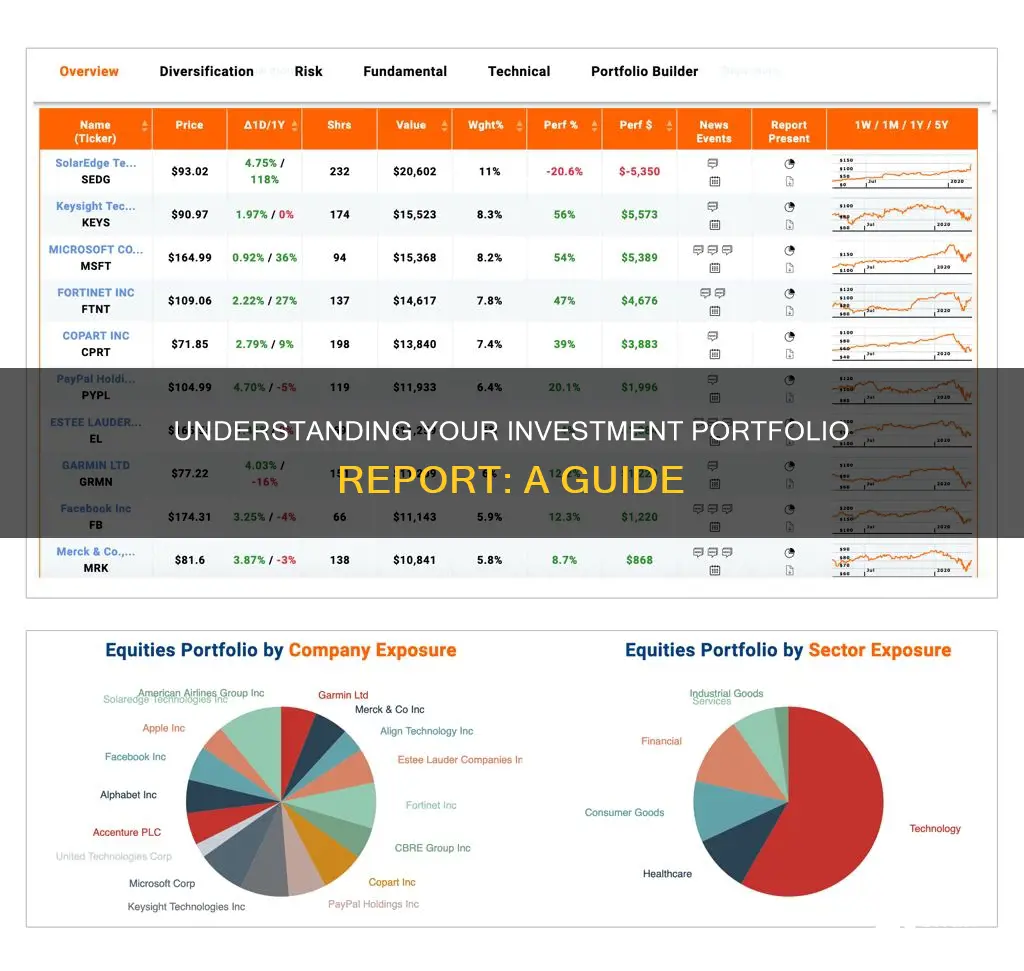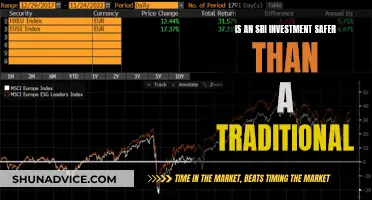
Reading an investment portfolio report is a critical skill for anyone looking to manage their money effectively. These reports provide a detailed overview of your investments, including the total value of your account, any changes since the last statement, and the performance of your investments. By understanding how to interpret these reports, you can make informed decisions about your investment strategy and ensure you are on track to meet your financial goals. This involves reviewing account activity, evaluating performance, confirming your risk level, and maximising the benefits of your account. While it can be tempting to ignore these statements, doing so could mean missing out on opportunities or, worse, failing to spot mistakes or fraud.
What You'll Learn

Understanding the purpose of an investment portfolio summary
An investment portfolio summary is a document that offers a wealth of useful information about your investments. It provides a detailed overview of your portfolio's performance and helps you understand where your investments are and if you are on track to meet your financial goals. Here are some key aspects to consider when reviewing an investment portfolio summary:
- Big-Picture View: An investment portfolio summary provides a comprehensive view of your entire portfolio, allowing you to assess the performance of your investments as a whole. This includes information about your current asset allocation, such as the percentage and dollar value of your investments in different asset classes like equities, fixed income, and others.
- Individual Asset Details: While providing a broad overview, the summary also offers a focused look at the individual assets within your portfolio. It spells out the quantities and dollar values of each asset, helping you understand their contribution to your overall asset allocation.
- Performance Evaluation: The summary includes sections like "Performance Summary" and "Portfolio Holdings," which give you a detailed analysis of how specific sectors and individual assets have performed during a particular period, typically year-to-date. This information is crucial for evaluating the success of your investment strategy.
- Alignment with Financial Plan: Although the summary provides valuable insights, it's important to consider it in the context of your overall financial plan. Creating a financial plan helps align your investment strategy and allocation with your personal goals, ensuring that your investments are working towards your desired objectives.
- Key Metrics and Data: The portfolio summary presents essential metrics and data points for each asset. This includes information such as the weight or percentage of each asset in your total portfolio, the cash invested, cost basis, value, unrealized gains or losses, cumulative income, and current yield. These details provide a deep understanding of the performance and potential returns of each investment.
- Decision-Making and Adjustment: By reviewing your investment portfolio summary, you gain valuable insights that facilitate informed discussions with your investment advisor. This knowledge empowers you to make strategic decisions and adjustments to your portfolio, ensuring it remains aligned with your risk tolerance, current market conditions, and financial objectives.
In summary, the purpose of an investment portfolio summary is to provide a clear and detailed picture of your investments' performance, composition, and potential. It serves as a tool to help you track progress toward your financial goals, make informed decisions, and ensure your investment strategy aligns with your risk tolerance and overall financial plan.
Creating a Personalized Investment Portfolio: A Beginner's Guide
You may want to see also

Interpreting pie charts and tables
Pie Charts:
Pie charts are a common way to visualise your investment portfolio's diversification. Each slice of the pie represents a specific asset class or investment, and the size of each slice indicates its percentage of the total portfolio. They offer a quick overview of how your investments are distributed, helping you spot any imbalances.
However, pie charts have limitations. They can become cluttered and hard to interpret when dealing with numerous investments or asset classes. That's when alternative visuals, like bar charts, come in handy.
Tables:
Tables complement the visuals by providing specific data points. They display the performance of your portfolio, identifying sectors with positive or negative yields. This information is crucial for making informed investment decisions.
For example, the annual measure of returns on investments is a critical data point in a table. It shows the profits and losses from your total stock purchases. This data is pulled from multiple financial sources to give you an overall view of your portfolio's performance.
Combining Visuals and Tables:
Visualising your portfolio through pie charts, bar charts, or other methods helps you understand the intricate relationships between your investments. Combining these visuals with tables empowers you to make data-driven decisions.
For instance, a line chart or column chart can illustrate your portfolio's value over time. This helps you track its performance and make adjustments as needed.
Additionally, a sector summary table provides high-level visual indicators to help you identify sectors that are doing well or underperforming. This information guides your investment strategies and prompts you to dig deeper into specific sectors.
In conclusion, interpreting pie charts and tables is essential for grasping the diversification and performance of your investment portfolio. They provide a visual snapshot of your investments, enabling you to make more informed decisions to align with your financial goals and risk tolerance.
Savings vs Investments: What's the Real Difference?
You may want to see also

Evaluating performance
Evaluating the performance of your investments is a critical part of managing and monitoring your assets over time. Here are some key points to consider when evaluating the performance of your investment portfolio:
Frequency of Evaluation
It is generally recommended to conduct a yearly evaluation of your investments, preferably at the same time each year. This allows you to keep track of your holdings and progress towards your investment goals. It also helps you identify when it's time to rebalance your portfolio.
Consolidated Statements
If you have investments with multiple financial firms or different types of accounts, you may need to review several statements to get a comprehensive view of your portfolio's performance. Consolidated statements from a single financial firm can provide an overview of all your accounts with them.
Performance Measures
When evaluating performance, consider the following measures:
- Yield: Expressed as a percentage, yield measures the income generated by an investment over a specific period, typically a year, relative to its price. This includes yields on bonds, stocks, and conventional CDs.
- Rate of Return: This measures the total money made or lost on an investment. To calculate the total return, add any increase in value and income generated, then divide by the initial investment amount to get the percentage return.
- Annualized Return: To compare the performance of investments held for different periods, calculate the annualized return using the formula: AR = (1 + return)^(1 / years) - 1.
- Transaction Fees: Ensure you factor in transaction fees, especially when calculating returns on actual gains or losses, to get an accurate picture.
- Taxes: Consider the impact of taxes, including capital gains and losses, on your investment returns.
- Inflation: For long-term investments, inflation can significantly affect your returns, as it erodes the value of your money over time.
- Rebalancing: Be prepared to adjust your portfolio when needed. This involves making changes to your asset allocation to align with your investment strategy and goals.
Portfolio Returns and Risk
When evaluating portfolio performance, it's crucial to consider both returns and risk. While total return is a key metric, it only tells part of the story. Risk measures, such as standard deviation, are equally important. Here are some additional points to consider:
- Performance Benchmarks: Compare your portfolio's performance against appropriate benchmarks, such as the S&P 500 for stocks or the Barclays US Aggregate Bond Index for bonds.
- Monitoring Frequency: Choose an appropriate frequency for monitoring your portfolio, such as quarterly, to periodically evaluate its performance.
- Risk Metrics: Utilize statistical risk metrics such as Standard Deviation, Beta, R-Squared, and Sharpe Ratio to assess the volatility and risk associated with your portfolio.
- Diversification: Employ diversification strategies by investing in a variety of assets to reduce volatility and improve risk-adjusted returns.
Exploring the Impact of Excess Savings on Planned Investments
You may want to see also

Assessing risk
Assessing the risk of an investment portfolio is an essential part of financial management. It helps investors understand the potential downsides of their investments and make informed decisions. While investing in financial markets can bring significant returns, it also carries significant risks. Therefore, it is crucial to conduct a thorough risk assessment before making any investment decisions.
There are various methods and tools available to assess the risk of an investment portfolio. One common approach is to use statistical measures such as standard deviation, Sharpe ratio, and beta. Standard deviation measures the volatility of an investment, indicating how much the returns deviate from the average. The Sharpe ratio helps investors understand the excess return they receive for holding a specific riskier asset. Beta, on the other hand, measures the systematic risk of a security relative to the overall stock market. It provides a quick way to compare the volatility of an investment with a benchmark, usually the broader market.
Another method to assess risk is through models such as Modern Portfolio Theory (MPT) and the Capital Asset Pricing Model (CAPM). MPT helps investors understand the risk of a portfolio relative to its expected return. It focuses on asset allocation, diversification, and rebalancing to construct an optimal portfolio. CAPM, on the other hand, is an equilibrium theory that analyses the relationship between risk and expected return. It helps investors appropriately price an asset by measuring the risk and expected return of an investment while considering the time value of money and risk compensation.
Additionally, the Value at Risk (VaR) approach provides a simple way to measure risk. VaR calculates the maximum loss that an investor might face at a given confidence level. For example, an investment with a 5% VaR means the investor has a 5% chance of losing their entire investment in a given month. While VaR is a popular measure, it has limitations, such as not providing information about the severity of losses beyond the VaR threshold.
It is also important to consider both systematic and unsystematic risks when assessing an investment portfolio. Systematic risk is associated with the overall market and affects all securities, making it unpredictable and challenging to mitigate. On the other hand, unsystematic risk is specific to a company or sector and can be mitigated through asset diversification.
By employing these risk assessment methods and models, investors can make more informed decisions, aligning their portfolios with their risk tolerance and financial goals.
Purchasing a Condominium: Saving or Investing?
You may want to see also

Reviewing fees
When reviewing fees in an investment portfolio report, it is important to be vigilant and thorough. Fees can eat into your investment returns and erode your wealth over time. Here are some key points to consider:
Understand the Types of Fees
Firstly, get familiar with the different types of fees that may be charged. These can include management fees, commissions, brokerage fees, financial advisor fees, and account maintenance fees. Management fees are typically charged by professional money managers for selecting the stocks and bonds that comprise mutual funds or exchange-traded funds (ETFs). Commissions are upfront fees charged when purchasing an investment product, such as an annuity or mutual fund. Brokerage fees are incurred when investing through a custodian or broker-dealer and can include trading fees, custody fees, and service fees. Financial advisor fees can be based on a percentage of your assets or a fixed/subscription fee. Account maintenance fees are charged by full-service or traditional brokerages for maintaining your account.
Locate the Fee Information
Investment fee information can be difficult to find and may be hidden in plain sight. Review your account agreement carefully, as it should list the range of fees you might be charged. Disclosure documents that you sign when purchasing an investment or annuity can also contain important fee information. Trade confirmations that you receive for each trade placed will outline any trading fees. Additionally, mutual fund and ETF websites are required to disclose all fees, so you can look up this information online.
Compare and Evaluate Fees
Once you have identified the fees, it's essential to compare and evaluate them. Use tools like FINRA's free fund analyzer tool to check if the expense ratio of your fund or ETF is high or low. Opt for low-cost index funds or exchange-traded funds, which typically have lower fees. If you work with a broker, be cautious of recommendations for "A-share" mutual funds, as these often have high upfront sales loads and expense ratios. Consider using robo-advisory firms or low-cost target-date retirement funds as more cost-efficient alternatives. When it comes to financial advisors, hiring a certified financial planner who charges by the hour or a flat fee can be more cost-effective than paying an annual fee based on a percentage of your assets.
Monitor for Unexpected Charges
Regularly review your investment portfolio reports to catch any unexpected or excessive charges. Be cautious of unanticipated handling charges, costs, or commissions. If you notice any discrepancies or unauthorised fees, don't hesitate to contact your financial professional or brokerage firm for clarification. It's important to stay vigilant and proactive in managing your investment fees to ensure they don't negatively impact your returns.
Savings, Investments, and the Economy: National Symbiosis
You may want to see also
Frequently asked questions
The purpose of an investment portfolio summary is to understand where your investments are and if you’re on track to meet your financial goals.
The first page of a portfolio summary typically includes a topline summary of the current asset allocation and recent factors affecting any change in its value. This is often presented in the form of pie charts, which break down the portfolio into major asset classes and sectors. The summary is followed by two sections: Performance Summary and Portfolio Holdings.
An annual report is a marketing tool for investors that includes illustrations, a letter from the chair or CEO, and a financial overview. A 10-K report is a longer, more detailed document that a company is required to submit to the Securities and Exchange Commission (SEC). It includes a description of the company, risk factors, legal proceedings, and financial data.
Some important things to look for include the statement period or end date, account ownership and type, financial professional's contact information, clearing firm information, account summary, fees, account activity, and portfolio detail.
It is recommended to review your investment portfolio reports regularly, either monthly, quarterly, or at least once a year, to ensure your investments are aligned with your financial goals and risk tolerance.







